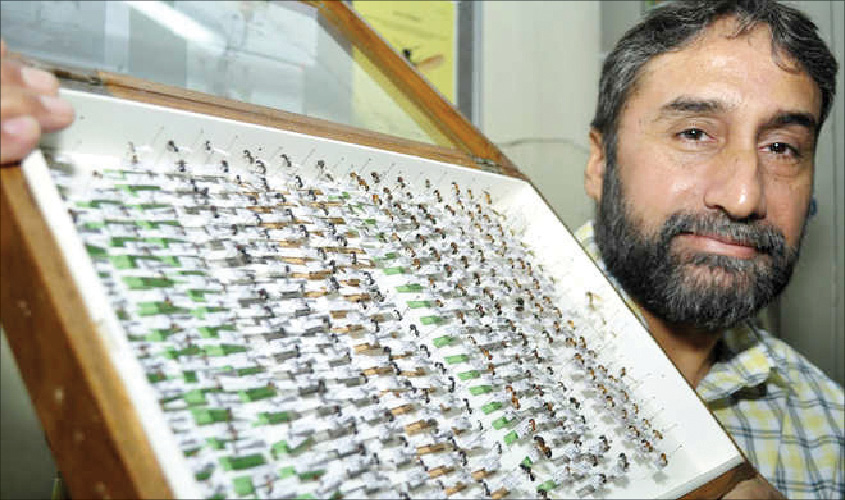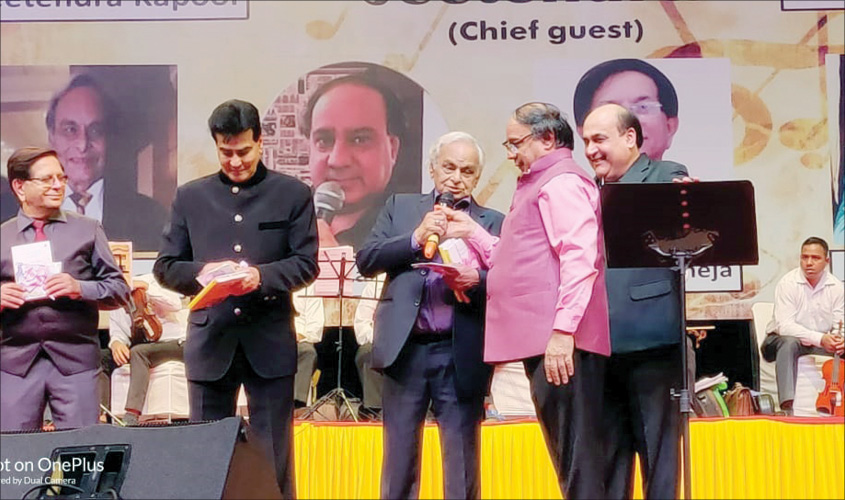‘Give Bharat Ratna to Rafi’
Late singer Mohammad Rafi’s fans want him to be awarded the Bharat Ratna. For which superstar and yesteryears’ “Jumping Jack” of Hindi cinema, Jeetendra (75) came to Delhi to launch a signature campaign to seek the coveted award for “Rafi Sahab”.
On 31 July, the 38th death anniversary of Rafi, a musical tribute was paid to him at the Siri Fort auditorium. Jeetendra remembered the singer in the presence of the latter’s youngest son Shahid Rafi, who resembles his father and even presents shades of his “Abba’s” voice. The evening, full of rendition of songs of Rafi by many artistes, once again showcased star-struck Delhiites’ craze for Bollywood. Many 60+ men and women enacted Jeetendra’s jitter, shake and twist in his inimitable Indo-western fusion style, even as the superstar himself broke into a brief jig on popular public demand.
“Rafi Sahab lives in our hearts and even the coming generations will never forget him,” said Jitu, as he enthralled the audience with anecdotes about his trademark white dress and shoes.
The “Rafi Night” was organised by singer and music director Suresh Raheja and well-known Delhi-based advocate, Sunil Kapoor (61), who is co-starring with actor Dharmendra in the upcoming film, Tiger Trail. The 85-year-old veteran music director Anandji (of Kalyanji-Anandji fame) applauded as Kapoor sang songs like Pukarta chala hoon main, Mast baharon ka main aashiq and Kaun hai jo sapno mein aaya, among others. Jeetendra also unveiled the second volume of Sunil Kapoor’s book, The Peacock Feather, a collection of short stories, co-authored with his chartered accountant twin brother Sudhir Kapoor, and the second edition of his instrumental music CD.
Raheja, who is anchoring the campaign for seeking a Bharat Ratna for Rafi, also sang several songs of the late singer. He announced that signatures of Rafi’s fans will be given to Union Home Minister Rajnath Singh soon with the request for a Bharat Ratna.
“Not many know that Rafi sung over 27,000 songs, not only in many Indian languages, but also in some foreign languages including English, Persian, Sinhalese, Creole and Dutch,” Sunil Kapoor told The Sunday Guardian.
Didi is a crowd rouser
West Bengal Chief Minister Mamata Banerjee has no control over her words. It is not that she is not aware of this “fault line” in her make-up. But on several occasions, she lets it happen deliberately, with the sole aim to keep her minority vote bank intact.
For political gains, Mamata has been opposing the draft National Register of Citizens (NRC) for long. But her latest outburst has shocked everyone. “She should not be a rabble-rouser, making inflammatory statements all the times,” say leaders cutting across party lines, except for the Congress.
“Her civil war and bloodbath remarks were uncalled for,” a senior BJP leader was overheard saying in Parliament House’s Central Hall. “We never expected such irresponsible and extremely provocative comments coming from a Chief Minister. She is openly polarising society and deliberately inciting violence for her personal political gains.”
Her rivals believe that she is using this opportunity to become “a darling of the minorities” and topple all regional opposition leaders jostling among one another to fill the reported vacuum created by Congress president Rahul Gandhi, who is believed to have pulled out of the PM’s race in the next Lok Sabha elections.
“Mamata cannot brand the entire NRC exercise as victimisation of immigrants belonging to a particular religion and conveniently disassociate herself from the entire episode,” said a BJP’s ally from Uttar Pradesh, commenting that the NRC was a result of the Assam Accord signed by then Prime Minister Rajiv Gandhi in 1985. Mamata was the youngest MP of the ruling Congress at the time. “Didi cannot change the three-decade-old narrative now and give it a communal twist to suit her political agenda,” said a saffron parivar leader, pointing out that the Assam Accord said foreigners who came to Assam on or after 25 March 1971, should continue to be “detected”, “deleted” and “expelled” in accordance with the law.
Private entities will maintain three Sikh war memorials
The Punjab administration has decided to hand over the operation of three important Sikh war memorials to private entities, keeping with the “Adopt a Heritage” scheme of the Central government.
These are: Fateh Burj at Chappar Chiri in Mohali; Vadda Ghalughara in Kup Rohira village (Sangrur district); and Chotta Ghalughara in Gurdaspur. At present, these are maintained by the Housing Department through local development authorities.
Fateh Burj commemorates the victory of Banda Singh Bahadur over Mughal governor Wazir Khan. It was built at a cost of Rs 46.43 crore. Its annual maintenance cost is about Rs 87 lakh.Chotta Ghalughara was built in the memory of 11,000 Sikhs who attained martyrdom during war with the Mughal army in 1746. It was built at cost of Rs 18 crore. It requires Rs 38 lakh per annum for maintenance.
Vadda Ghalughara, spread over 9.5 acres, was built in the memory of 35,000 Sikhs who were massacred by the army of Afghan invader Ahmed Shah Abdali on 5 February 1762. Built at a cost of Rs 24.7 crore, it requires Rs 50 lakh every year for maintenance.

Here comes the Man who knows all the secrets of ants
Meet Dr Himender Bharti, popularly known as the “Ant-Man” the world over. He is a professor in the Department of Zoology and Environmental Sciences, Punjabi University, Patiala. He is a member of the International Union for Conservation of Nature and is involved in the conservation of Asian ants.
“Leptogenys Bhartii”—a species of ants—has been named after him. The 11-12 mm ant was found in the southern foothills of the Pir Panjal range in Jammu & Kashmir by Dr Shahid Ali Akbar, a scientist from Srinagar.
Known as an encyclopaedia on ants, Bharti joined the Department of Science and Technology, Punjabi University, as a scientist in 1998. It was during his master’s degree that he read about evolutionary biologist Edward Osborne Wilson, whose non-fiction novels on ants got his attention, and he started trailing the insect. The myrmecologist (the study of ants) was impressed by the “special attributes” of ants and decided to pursue research in this field. According to him, ants are social organisms. They move in groups and live in “colonies”. He started studying their physiology, genetics, behaviour and evolution.
His study revealed that India has 835 species of ants. Out of these, he discovered 80 species. He visited Southeast Asia, Pakistan, Sri Lanka, Vietnam, Bhutan, Austria, Thailand and Malaysia in search of these species.
The Himalayas and the Western Ghats have many ant species—656 from 88 genera were recorded from the Himalayas, while 455 from 75 genera were recorded from the Western Ghats. West Bengal has the highest number of species (382), followed by Sikkim at 276. The average life span of an ant is 12 to 13 years.
Bharti has 13 students pursuing PhD in myrmecology under his guidance. Many scientists are trying to understand how climate change will affect the world, by determining the thermal tolerance level of various species of ants, and then predicting what will happen if our planet gets hotter. Researchers are studying how the gene expression of ants can control the environment.
Bharti is working on the “chemical communication of ants”, known as chemical ecology. “Millions of ants stay in a colony; they go about doing their work without communicating. But the ants have the highest form of communication, which takes place through the release of chemicals. Myrmecologists are even trying to understand human behavioural patterns through ants. Global scientists are trying to discover a software to control traffic by using the ant algorithm (how ants move in their colonies without bumping into each other),” says Bharti, who has named two ant species after his daughters, Mermica Adrijae and Mermica Urvijae.
Invasive species of ants can disturb the entire ecosystem by wiping out native species. Red Fire ants are said to have invaded America, Australia and Japan and destroyed the habitat of native ants, says Bharti warning that “there is a great possibility of invasive species invading India as well”.

